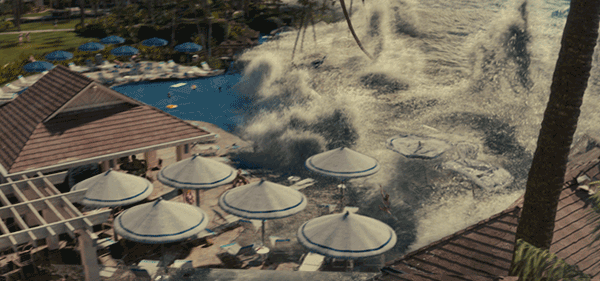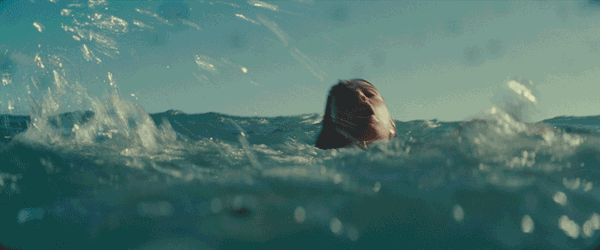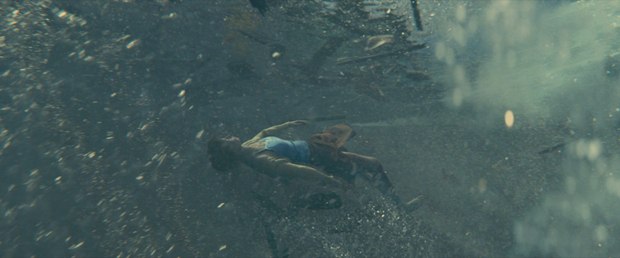Michael Owens and Scanline discuss creating the tsunami and the hereafter in Clint Eastwood's latest departure.
Check out the Hereafter trailer and clips at AWNtv!
Clint Eastwood adds yet another new, revealing side to his filmmaking repertoire with Herafter. Matt Damon plays a conflicted medium drawn to a French journalist (Cecile De France), who survives a tsunami and is haunted by a near-death experience.
Michael Owens, who is Eastwood's long-time visual effects supervisor, collaborated with ScanlineVFX/Los Angeles on the tour de force tsunami sequence at the beginning, and visions of the hereafter scattered throughout. The challenges were obviously different both technically and stylistically.
To begin with, Owens did a four-staged previs of the tsunami sequence, which is smaller in scale and less fanciful than the one Scanline did for 2012.
"Clint is very studied but when he actually goes to shoot, he doesn't want to have any of that reference with him," Owens explains. "So he was thrilled to have the previs and the edits that I had done so he could see how it fit together. But when we go to shoot, I'll remind him of stuff that I think will be cool. But it usually ends up being a hybrid from the previs because that's the style of filmmaking that Clint does. Quite frankly, it adds a loose, organic quality to the equation that has a little more randomness to it.
Led by co-VFX Supervisors Stephan Trojansky and Bryan Grill, CG Supervisor Danielle Plantec and Compositing Supervisor Joe Farrell, Scanline provided 169 shots for Hereafter.
The key sequence was obviously the recreation of the tsunami, which drew upon a wide array of techniques: Full CG water shots and CG water extensions to water plates, digital doubles, CG set extensions, matte paintings, digital make-up vfx and full CG environments with extensive destruction, from toppling digital palm trees to colliding digital cars.
The tsunami wave comprised half the work. "Not only did the film offer us the opportunity to work with legendary, Academy Award-winning director Clint Eastwood, but also it gave us a great opportunity to build on our work on 2012, and to take it to another level altogether in terms of complexity, particularly in the area of water interaction with digital doubles," suggests Joel Mendias, exec producer, ScanlineVFX/Los Angeles.
"Digital doubles figured extensively in this sequence. We had a motion capture shoot, to build a library of moves for digi-doubles (including Massive doubles). As might be expected, motions included running and stumbling actions, as well as various reactions to the wave, accomplished with more conventional falls into crash pads. But to simulate characters in water, we also used a traveling wire rig, in order to capture characters in water -- from getting pummeled by strong currents, to treading water and trying to surface and stay afloat and floating dead underwater. Ultimately, much of this motion capture was combined with key frame, traditional animation, as animators worked to incorporate characters into digital water flows, both above and below water.
"Several key shots were almost entirely if not entirely digital, and they certainly had their challenges. But among the most challenging were shots incorporating tank or open-ocean plate photography of actors into backgrounds that were 100% digital, including water, environments and digital doubles. The first step involved putting these live action plates through post-vis re-photography, creating new and more dynamic camera moves and simultaneously beginning to block out background action and destruction. Once post-vis moves were semi-locked, the painstaking process of seaming the foreground water plate with the fully digital background would begin. In order for these shots to succeed, the CG/live-action water hook-up had to be seamless, even throughout sometimes big, sweeping camera moves. Additionally, the look and dynamics of the water and debris needed to be spot on. Hand in hand with that was the process of building mid- and- background CG environments with heavy destruction, water splashes and digital doubles. In the end, these rather complex extension shots (which we affectionately nicknamed the 'tea cup' shots) function as a ride of sorts, as camera and characters get swept through the streets of a beachfront tropical resort village being ravaged by a tsunami. Cars and people collide, power lines spark and transformers explode, palm trees cascade -- all digitally."
The underwater environment was pivotal as well. Some shots were accomplished with GS tank photography composited into a virtual underwater environment comprised of fully digital debris, buildings, cars, silt, water and water particulate. But one key shot -- spanning more than 300 frames and approximately 13 seconds -- features a fully digital underwater environment complete with a digital De France, floating past camera, unconscious. Visibility was very carefully art directed in these shots, as Scanline worked to combine dirty muddy water mixing with clearer water, darkness mixing with shafts of light, to allow them to see under water while still retaining the murkiness you would expect in a tsunami.
Meanwhile, depicting the hereafter provided its own difficulties. Shot with the Red camera (a first for Eastwood shooting digitally), the visions are very subtle, according to Owens. In fact, when doing a temp version, Steven Spielberg, an exec producer, had a playful response when recognizing footage from Close Encounters of the Third Kind.
"After taking footage like that and taking stuff into Nuke, Joe Farrell developed 3D environments out of 2D objects into a 2/5D look," Owens continues. "But we explored all kinds of things with Joe and the tricky part was that hereafter had to be takeaway after the [tsunami] sequence because that is what's disturbing to her. The tsunami had to have enough weight and scariness to balance it. And then on top of that, what was tough was not overstating the hereafter for the audience. It took a lot of experimentation to find subtle differences and Joe and I did a lot of different things before finally winding up with what's in the movie.
"I knew it needed a horizon and I knew it needed some perspective of depth and I thought that we could probably get perspective through humanoid figures. You needed some sense of a sky and some sense of a ground plane. And yet you couldn't put anything man made in it so, with that in mind, we borrowed a little bit from 3D sets that we built and stripped them way down and just gave the faintest, ghostly feeling that there some sort of structure out there. And the camera is very fluid with wide angle lenses mixed with a shorter perspective when you get closer to a person."
Bill Desowitz is senior editor of AWN & VFXWorld.











